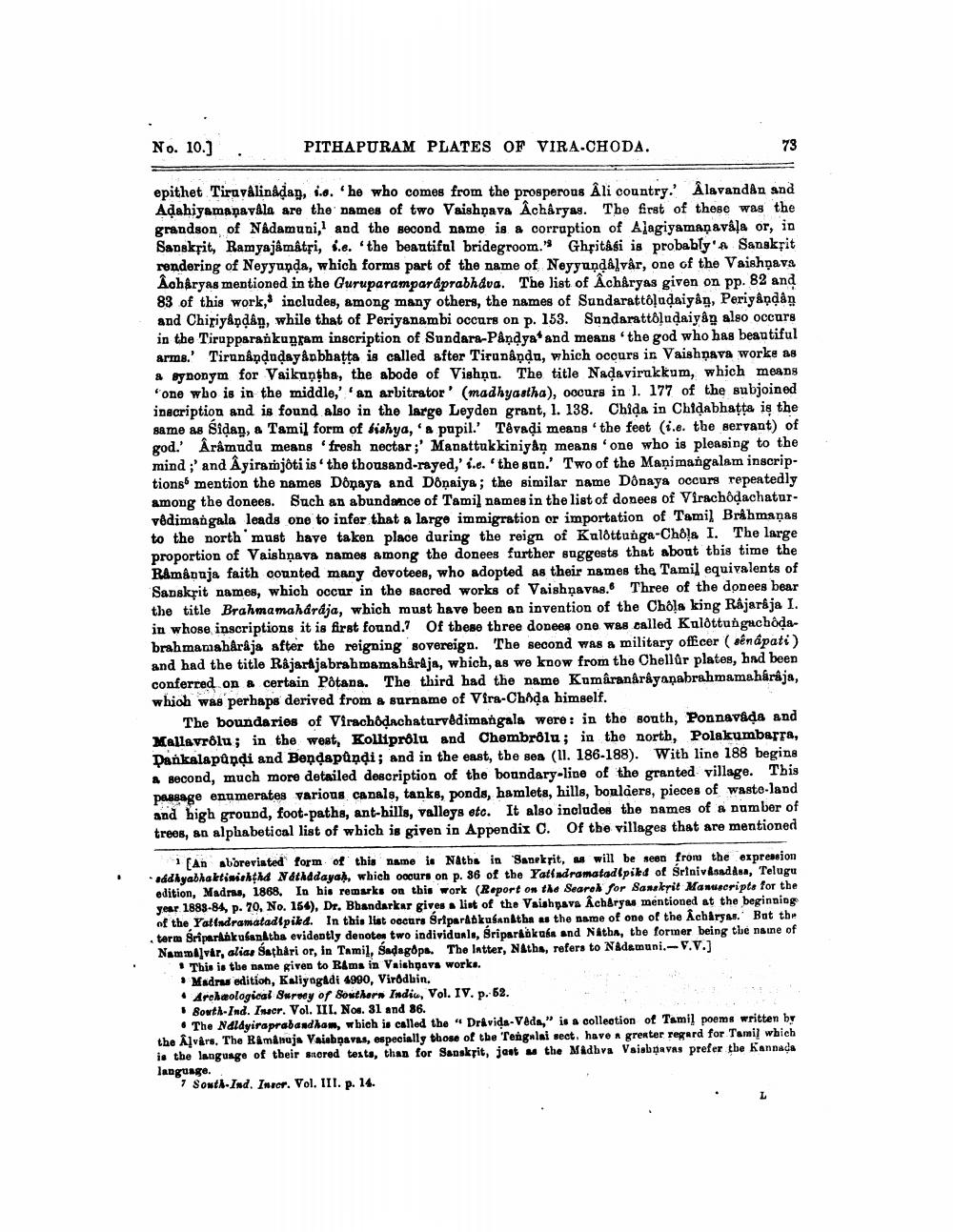________________
No. 10.)
PITHAPURAM PLATES OF VIRA.CHODA.
73
epithet TiruvAlinaday, i... he who comes from the prosperous Âli country. Alavandan and Adahiyamanavala are the names of two Vaishňava Acharyas. The first of these was the grandson of Nadamuni, and the second name is a corruption of Alagiyamanavala or, in Sanskrit, Ramyajâmâtri, i.e. the beautiful bridegroom.' Ghritasi is probably' Sanskrit rendering of Noyyunda, which forms part of the name of Neyyundå vår, one of the Vaishňava Achêryas mentioned in the Guruparamparaprabhava. The list of Acharyas given on pp. 82 and 83 of this works includes, among many others, the names of Sundarattoļudaiyán, Perigândân and Chiriyandan, while that of Periyanambi occurs on p. 153. Sandarattoludaiyan also occurs in the Tirupparankunram inscription of Sundara-Pandyat and means the god who has beantiful arms.' Tirunânduday&nbhatta is called after Tirunânda, which occurs in Vaishnava works as & synonym for Vaikuntha, the abode of Vishạn. The title Nadavirukkum, which means
one who is in the middle,'' an arbitrator' (madhyastha), occurs in l. 177 of the subjoined inscription and is found also in the large Leyden grant, 1. 138. Chida in Chidabhatta iş the same as Sidan, a Tamil form of fishya, 'a papil. Tévadi means the feet (i.e. the servant) of god. Åråmudu means 'fresh nectar;' Manattukkiniyan means one who is pleasing to the mind and Ayirsmjôti is the thousand-rayed,' i.e. the sun.' Two of the Manimangalam inscriptions mention the names Döpaya and Doņaiye; the similar name Donaya occurs repeatedly among the donees. Such an abundance of Tamil names in the list of donees of Virachôdachatur. vedimangala leads one to infor that a large immigration or importation of Tamil Brahmaņas to the north must have taken place during the reign of Kalóttunga-Cho! I. The large proportion of Vaishṇava names among the donees further suggests that about this time the Ramâonja faith counted many devotees, who adopted as their names the Tamil equivalents of Sanskrit names, which occur in the sacred works of Vaishṇavas. Three of the donees bear the title Brahmamahardja, which must have been an invention of the Chola king Rajaraja I. in whose inscriptions it is first found. Of these three doneer one was called Kulottungachôdabrahmamaharaja after the reigning sovereign. The second was a military officer (senapati) and had the title Rajarajabrahmamaharaja, which, as we know from the Chellûr plates, had been conferred on a certain Pôtana. The third had the name Kumaranarayanabrahmamahárâja, which was perhaps derived from a surname of Vira-Choda himself.
The boundaries of Virachôdachaturvedimangala were: in the south, Ponnavada and Mallsvrôlu; in the west, Kolliprolu and Chembrölu; in the north, Polakumbarra, Dankalapundi and Bendapundi; and in the east, the sea (II. 186-188). With line 188 begins A second, much more detailed description of the boundary-line of the granted village. This passage enumerates various canals, tanks, ponds, hamlets, hills, boulders, pieces of waste-land and high ground, foot-paths, ant-hills, valleys etc. It also includes the names of a number of trees, an alphabetical list of which is given in Appendix C. Of the villages that are mentioned
[An abbreviated form of this name is Naths in Saneksit, us will be seen from the expression Iddhyabhaktimiehend Nathddaya, which occurs on p. 36 of the Yatindramalad pild of Srinivasadasa, Telugu edition, Madras, 1868. In his remarks on this work (Report on the Seared for Sanskrit Manuscripts for the year 1888-84, p. 70, No. 154), Dr. Bhandarkar gives a list of the Vaishnava Acharyas mentioned at the beginning of the YatIndramatad piked. In this list occurs Sriparábkusanktha as the name of one of the Acharges. But the term Sriparkhkufanátha evidently denotes two individuals, Sriparkkua and Natha, the former being the name of Nammi var, alia, Sathari or, in Tamil, Sadagðps. The latter, Naths, refers to Nadsmuni.-Y.V.]
This is the name given to R&ms in Vaishpava works. • Madrus edition, Kaliyagadi 4990, Virodbin. • Archæological Survey of Southern India, Vol. IV. p.62.
South-Ind. Incr. Vol. III. Nos. 31 and 86.
• The Ndldyiraprabandhan, which is called the “Drávida-Veda," is a collection of Tamil poems written by the Alvârs, The Ramanuja Vaisbộavas, especially those of the 'Tengalai sect, have a greater regard for Tami) which in the language of their stored tests, than for Sanskrit, jest w the Madhva Vaisbavas prefer the Kannada language. 7 South-Ind. Inrer. Vol. III. p. 14.
.




